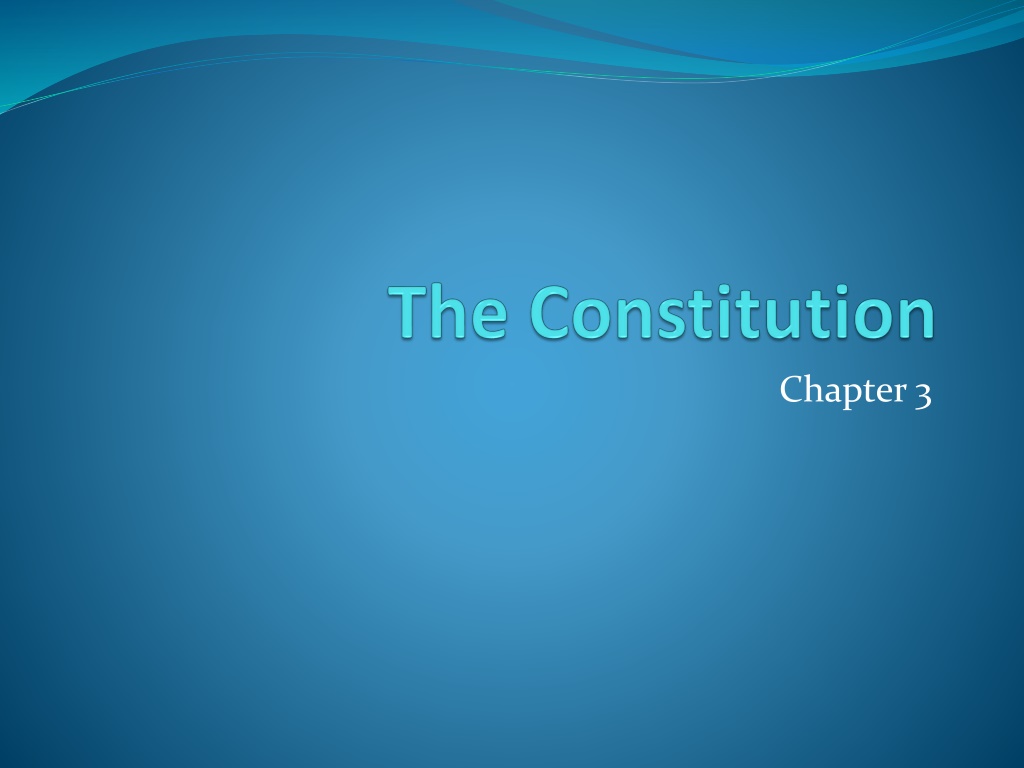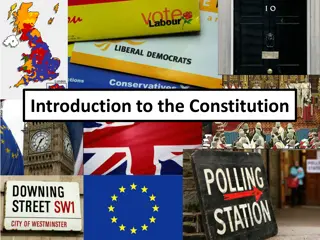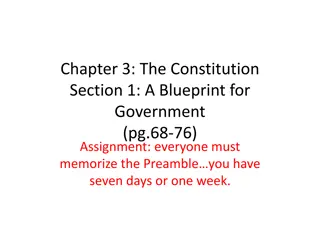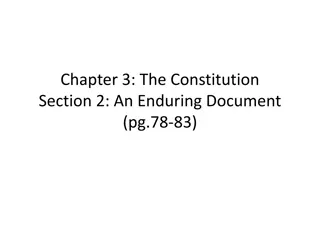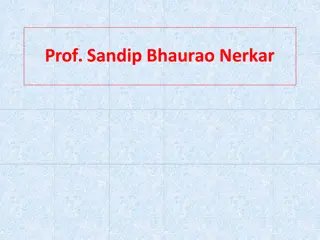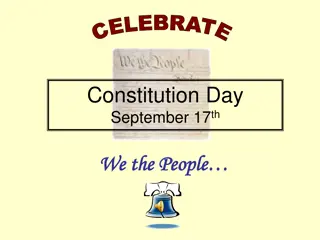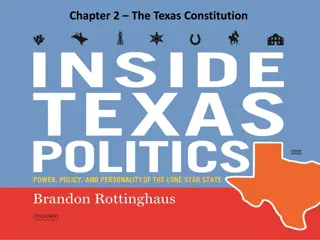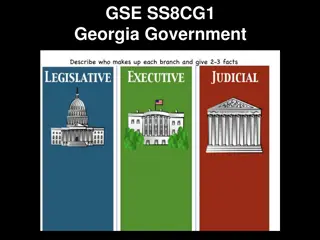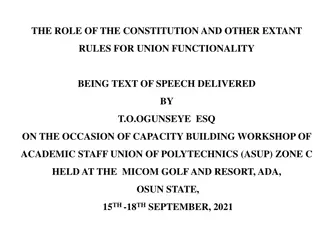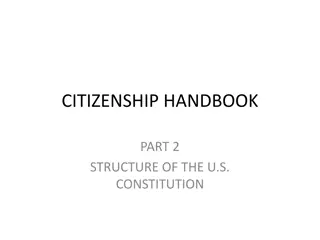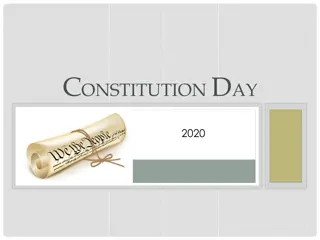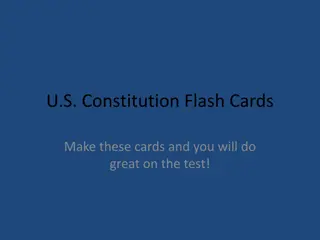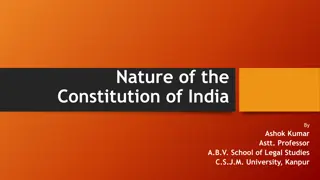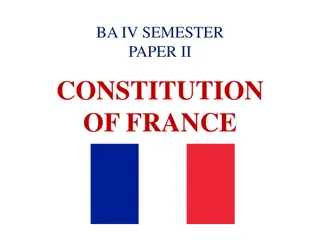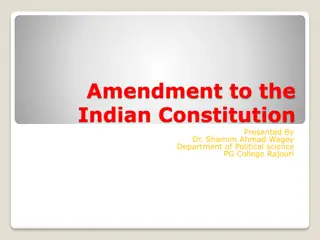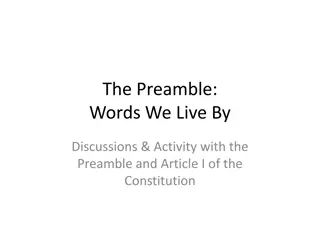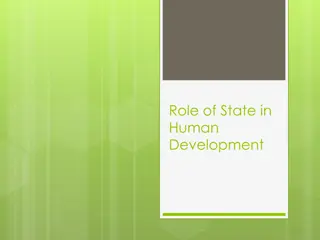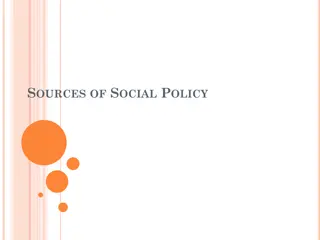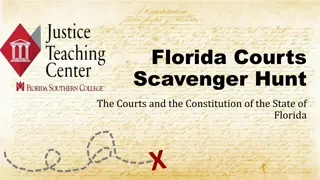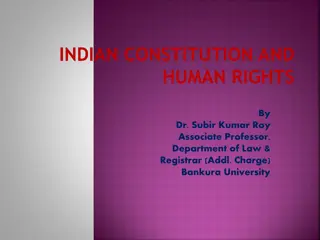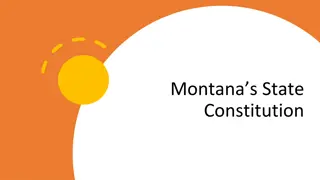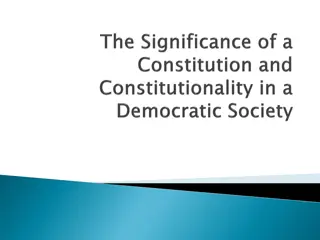Exploring the Goals and Principles of the US Constitution
Delve into the six goals outlined in the Constitution's Preamble, including forming a more perfect union, establishing justice, ensuring domestic tranquility, providing for the common defense, promoting the general welfare, and securing the blessings of liberty. Discover how the framers addressed concerns about government strength and the suppression of liberties, leading to the principles of dividing, distributing, and balancing government power to uphold the will of the people.
Download Presentation

Please find below an Image/Link to download the presentation.
The content on the website is provided AS IS for your information and personal use only. It may not be sold, licensed, or shared on other websites without obtaining consent from the author. Download presentation by click this link. If you encounter any issues during the download, it is possible that the publisher has removed the file from their server.
E N D
Presentation Transcript
Blueprint 45oo words Three parts Preamble broad goals (why) 7 articles create structure of US govt. Amendments 27 changes
Objective Explain & analyze the six goals & principles of the U.S. Constitution.
6 Goals of the Constitution Preamble - We the People of the United States, in Order to form a more perfect Union, establish Justice, insure domestic Tranquility, provide for the common defense, promote the general Welfare, and secure the Blessings of Liberty to ourselves and our Posterity, do ordain and establish this Constitution for the United States of America.
6 Goals of the Constitution Form a more perfect union 1. 2. Establish Justice 3. Ensure domestic tranquility 4. Provide for the common defense 5. Promote the general welfare 6. Secure the blessings of liberty
Goals of the Constitution Govt. tasks Raise an army Pay its bills Conduct relations with foreign countries Concerns Some Framers strong reservations Some Completely opposed Worried about strong national govt.
Governing after the Revolution Framers concerned with Govt. suppressing the liberty of its citizens What are liberties?
Addressing the Problem of Governing Govt. obliged to control itself Est. a system of law Knowledge that decision would have long lasting consequences Giving people freedom while controlling them
Principles of govt. in the Constitution Framers solution Governing document Divide distribute & balance govt. power Uses of power Govt. power subject to will of the people Power as voters
Principles of govt. in the Constitution Bill of Rights Final check on power Inclusion of Bill of Rights 1791 Restraints Placed specific restraints on power of govt. Cannot violate basic rights of citizens
Basic Principles Popular sovereignty Limited govt./rule of law Separation of powers Checks & balances Judicial review Federalism Page 70-76
Question Describe how the Constitution provides a blueprint for governing the nation. By setting out 6 principles of governing that, if followed would allow its goals to be accomplished.
Question popular sovereignty How is popular sovereignty expressed in the Constitution? We the People of the United States,
Question limited govt. How might civil society support the principle of limited government? being active in the political process, citizens can make better choices when they vote and hold the government accountable when it exceeds its power or fails to address society s needs.
Question separation of Pwrs. How does the structure of the Constitution reflect the separation of powers of government? three branches of government are listed in three separate articles
Question Checks & Balances Name at least one check or balance that each branch of government has on the others? legislative: can reject the executive branch s job appointments Executive: can veto laws passed by legislative branch Judicial: can rule acts of other branches unconstitutional
Question Judicial Review How might the power of judicial review affect ordinary citizens? Marbury v. Madison (1803) * est. judicial review- power to decide whether laws are constitutional
Question - Federalism Why do supporters of states rights refer to the 10th Amendment to strengthen their arguments? Because the amendment guarantees that powers not specifically delegated to the federal government by the constitution, nor prohibited by it to the states are reserved to the states or to the people.
Objective Understand why the Constitution is both a product of its time & a document for all time. (Amendment Process)
Amending the Constitution (anti-federalists)Jefferson (Federalists) Madison Not changed on a whim Change as society changed Laws & constitutions grow in authority & acceptance Changing Constitution could split the country Sectional rivalry leave the nation open to foreign influence
Amendment Process Power to change Article V page R29 Describes process of amending Constitution Proposed, ratified Two ways of proposing & ratifying (amend) E.g. 18th Amendment & 21st Amendment (alcohol)
Amendment Process Two step process required ratification by the states & so restricted power of Congress to change the Constitution Change reflects national will Principle? Popular sovereignty
racially profiled (airports) photo privacy right to shelter free hospital visits military stationed stateside citizens have right to approve/veto respect for all drinking age 18 1 1 1 1 1 1 1 1 116th Congressional session 1: Two sessions = a term the right to say no/ stand up to government the right to sue govt. basic health right education freedom rights children in the court system animal rights driving age 18 2 vice potus free lawyer for criminals to travel you don t work, you don't eat parents examined - children more state rights equality (women/gay) freedom of speech military disrespects right to life balanced budget prohibition of privacy invasion (technology) power of police officers, limit 2nd amendment (ban/limit/no shooting) drug use 1 1 1 1 1 1 1 1 1 1 1 1 1 Some of the Proposed Amendments to the U.S. Constitution during the 115th Congressional Term 2 2 2 2 2 3 4 4 6 6 Gay/same-sex marriage 14
Amendment Process By Congress, with approval of at least 2/3rds of both houses 2. By delegates at a national convention that is called by Congress at the request of at least 2/3rds of the state legislatures 1.
Ratifying an Amendment Congress sends proposed amendment to 50 states for ratification; states can ratify in two ways 1. Voted by state legislatures (3/4ths approval) 2. Citizens elect delegates to conventions to consider the amendments (3/4ths approval)
6 Proposed unratified Amendments 1. Congressional Apportionment Amend. Regulate the size of congressional districts Pending since 1789 (11 States) 2. Titles of Nobility Strip citizenship Pending since 1810 (12 States) 3. Corwin Amendment Harder to remove the institution of slavery Pending since 1861 (3 States) 4. Child Labor Amendment Federal govt. regulate child labor Pending since 1924 (28 States) 5. ERA Deprivation of equal rights 1972-1982 (35 states) 6. D.C. Voting Rights Amend. D.C. Full rights of states (voting, representation in Congress, electoral college) 1978-88 (16 States)
Questions What is the most common way of amending the Constitution? That means one way to propose and one way to ratify an amendment to the U.S. Constitution.
Objective Understand how the Federal Govt. applies the Constitution.
How does the Federal Govt. applies the Constitution? Legislative action Executive implementation Judicial interpretation
Legislative Action Article III Section 1 Supreme Court Judiciary Act 1789 Lower level federal courts
Legislative Action Congress pushes into areas where Constitution is silent New Technologies Threatening international circumstances Results in Congress testing constitutional boundaries
Executive Implementation Created agencies to implement Congress s laws Executive agreements - foreign policy
Judicial interpretation Est. the principle of judicial review Must interpret the 4th Amendment in light of changing conditions Riley vs. California (2014)
Question How has each branch of government put the Constitution into action? Cite an example
Criticisms of the Constitution Gridlock Questions about representation Electoral college Winner takes all elections (plurality)
